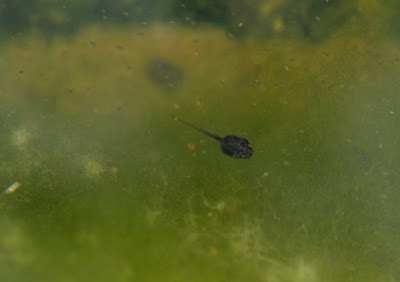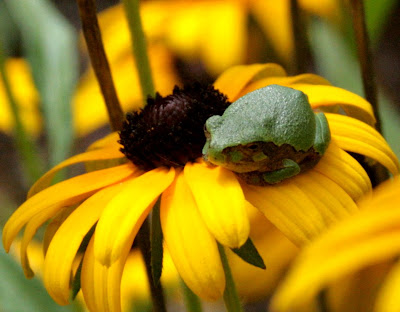Because this is my 50th post, I want to make it a little extra-special. What to do??? Perhaps highlights of our recent trip to Belize? No, I want to make that last for a number of posts parceled out so I can make it through the upcoming winter. Something about our cats? Oh heck no, too boring for everyone except me (I can hear you thanking me for nixing that idea). Photos and ruminations on the change of seasons? Too depressing to even contemplate. So I took a wander through my photo collection for inspiration and found --- TADPOLES TO FROGS. I hope you enjoy reading and looking as much as I enjoyed writing it and taking the photos.
It is the old chicken or egg conundrum; start with the adult frog or the baby tadpole? Well, since I choose to start this series in early summer, we will begin with an adult frog that inhabited our little garden pond. I believe this a Northern Leopard frog. There must be at least one other of the opposite sex around, although I saw only one at a time. This species reaches sexual maturity in 2 to 4 years, so these have been around for a few years at least. They seem to like the abundant mass of filamentous algae that is in our little pond.
 The second picture is the last time I saw this little frog. I am suspicious that it was eaten by raccoons that raid the pond almost nightly.
The second picture is the last time I saw this little frog. I am suspicious that it was eaten by raccoons that raid the pond almost nightly.
So, we have two kinds of frogs around. Will we see tadpoles of both in the pond? Below are photos of the tadpoles in chronological order. The little tadpoles seem to graze on the algae or critters in the algae. Perhaps that is why the adults like the algae so much.


A month or so later, these little guys and girls have gotten bigger. They really like to graze on the submerged rock ledge, probably so they can soak up the sun's warmth while eating. It just doesn't get better than that!
Pretty soon, they start to develop rear legs.


And now you can see that there are 2 kinds of tadpoles in the pond. See the little green at the bottom right? That one is going to be a Northern Leopard Frog. And I believe that others will be Gray Treefrogs.

After the rear legs start developing, the front legs show up and the tail starts to get pretty darn skinny.


 Just look at that sweet little froggie face.
Just look at that sweet little froggie face.At some point the Gray Treefrogs leave the pond environs. I found some young frogs in surprising places. Here is one on a wild raspberry bramble. That out of focus white thing in the second image is my thumb (for size comparison) - that is a wee little froggie.


I had never thought to look for frogs on flowers. This one looks quite happy on the Black-eyed Susan on a damp day.

 You can see the markings that are prominent along the sides of some of the Gray Treefrogs.
You can see the markings that are prominent along the sides of some of the Gray Treefrogs.



Excellent post Wilma to celebrate 50!
ReplyDeleteWe only have the one type of frog here, as far as I know, and it's been fascinating watching them develop and grow in my small wildlife pond.
Love the shots of them sunbathing on the rock, and the little green one on the leaf and flowers.
Great post.
Congratulation on post #50 Wilma. A beautiful collection of great photos with a lovely description of the life cycle of your frogs.
ReplyDeleteSometimes I wish my frogs had a bit more colour the number of times they make me jump when they suddenly leap out in front of me when I'm gardening.
Congrats on the 50 Wilma! Excellent subject for a post. They do look strange when the rear legs appear.
ReplyDeleteKeith -- According to the Minnesota Department of Natural Resources, we have 6 species of the Rana genus that includes all the true frogs and 3 genera (5 different species)of tree frogs, plus 3 species of the Bufo genus (toads). I really enjoyed watching them develop in the pond.
ReplyDeleteJohn -- all these frogs blend into the vegetation. They are hard to spot and tend to be evasive. To get many of the photos, I had to crawl the last 5 or so feet to the pond in order not to startle the tadpoles to bottom of the pond.
Rob -- thanks for visiting and commenting. It is nice to see that somebody reads and enjoys these posts that are flung so hopefully out into the aether ...
Congratulations on the #50.
ReplyDeleteExcellent series of photos. Love the bumped texture of the Gray Treefrog on the flower petals.
Looks like an avocado- with legs!
Madi -- you're right, it does look like an avocado with legs. A very, very, little avocado ...
ReplyDeleteThanks for following me, your latest post is great,you must have a good macro on your camera.
ReplyDeleteMy garden also has a large population of frogs but they won't spawn until March next year.
What a lovely 50th post Wilma! Your photos are so clear and I love tadpoles and frogs, I wish I had a pond! A very interesting post.
ReplyDeleteDavid - I never did get pictures of the eggs this year. i'll have to keep an eye out for them in early spring. Thanks for visiting my blog. Your trip looks fantastic!
ReplyDeleteShySongbird - thanks for visiting and for your kind comments. I had so much fun watching the process.
ReplyDeleteThe most probable is that some species of frogs or toads are eaten by raccoons. The same happens in Latin American countries, but anyway frogs normally have more than one enemy in nature.
ReplyDelete